pubhealth: Why Finnish babies sleep in cardboard boxes For 75...

Why Finnish babies sleep in cardboard boxes
For 75 years, Finland's expectant mothers have been given a box by the state. It's like a starter kit of clothes, sheets and toys that can even be used as a bed. And some say it helped Finland achieve one of the world's lowest infant mortality rates.
It's a tradition that dates back to the 1930s and it's designed to give all children in Finland, no matter what background they're from, an equal start in life.
The maternity package - a gift from the government - is available to all expectant mothers.
It contains bodysuits, a sleeping bag, outdoor gear, bathing products for the baby, as well as nappies, bedding and a small mattress.
With the mattress in the bottom, the box becomes a baby's first bed. Many children, from all social backgrounds, have their first naps within the safety of the box's four cardboard walls.
Mothers have a choice between taking the box, or a cash grant, currently set at 140 euros, but 95% opt for the box as it's worth much more.
The tradition dates back to 1938. To begin with, the scheme was only available to families on low incomes, but that changed in 1949.
(From BBC)
galaxyshmalaxy: NGC 884 & 869 - Double Cluster (by Captain...
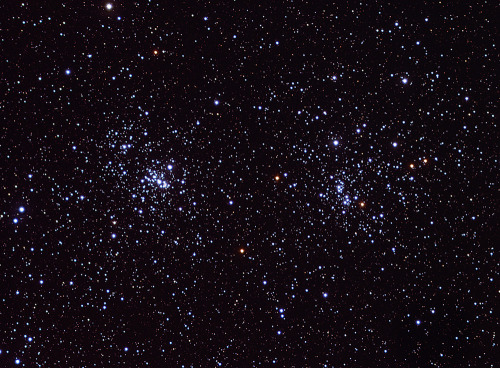
NGC 884 & 869 - Double Cluster (by Captain Tweaky)
uraniaproject: The Keyhole The heart of the Eta Carina nebula,...
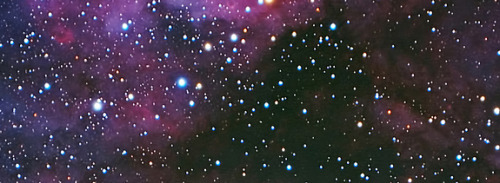

The Keyhole
The heart of the Eta Carina nebula, the star Eta Carina is the bright one just on the right of the "keyhole".
rfar: The Visual Patterns of Audio Frequencies Seen through...
rfar:
The Visual Patterns of Audio Frequencies Seen through Vibrating Sand
Youtube user Brusspup (previously here and here) who often explores the intersection between art and science just released this new video featuring the Chladni plate experiment. First a black metal plate is attached to a tone generator and then sand is poured on the plate. As the speaker is cycled through various frequencies the sand naturally gravitates to the area where the least amount of vibration occurs causing fascinating geometric patterns to emerge. There's actually a mathematical law that determines how each shape will form, the higher the frequency the more complex the pattern.
[source: Colossal]
sagansense: Heracleion Photos: Lost Egyptian City Revealed...
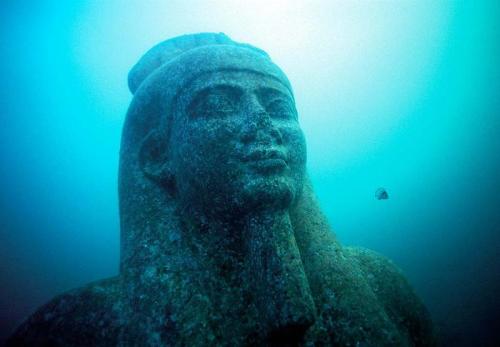
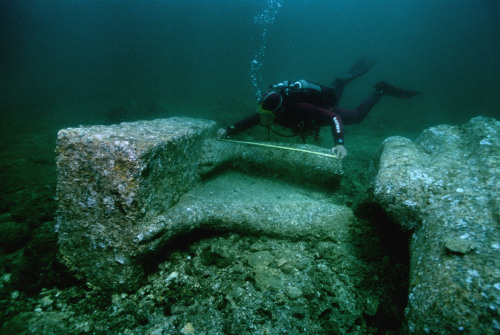

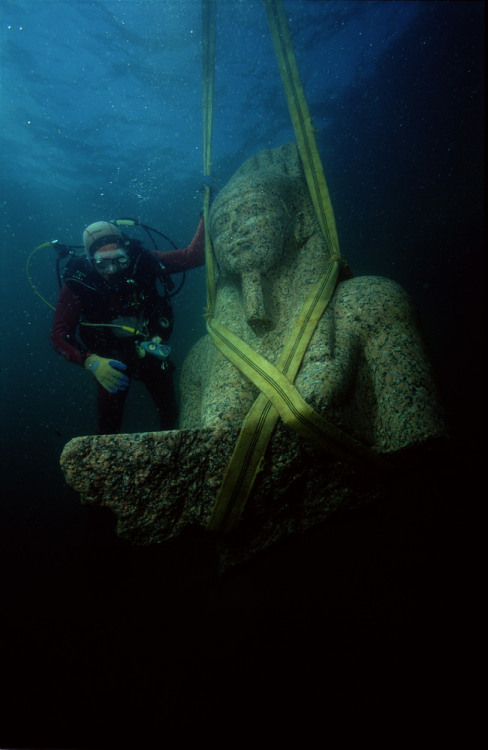
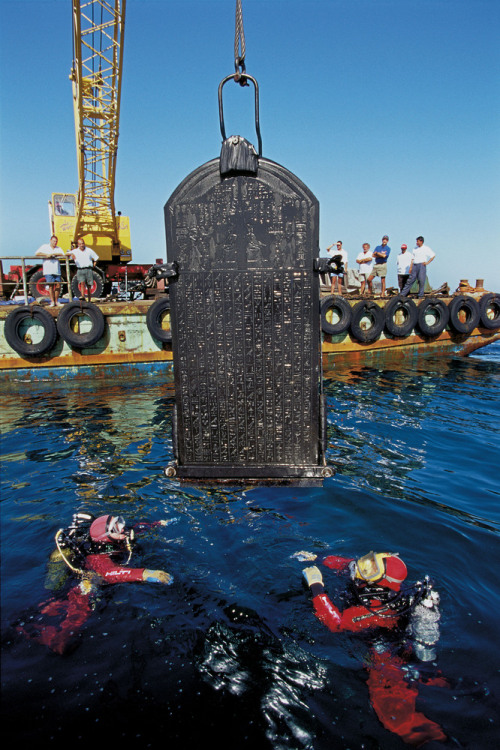
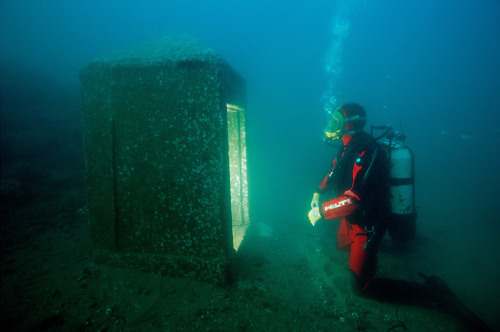
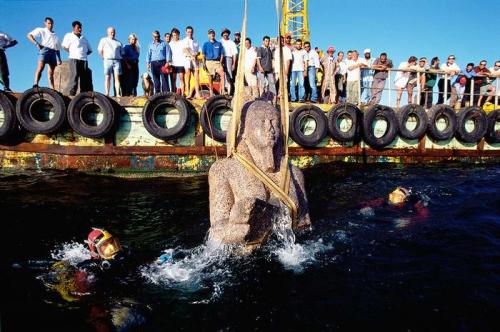
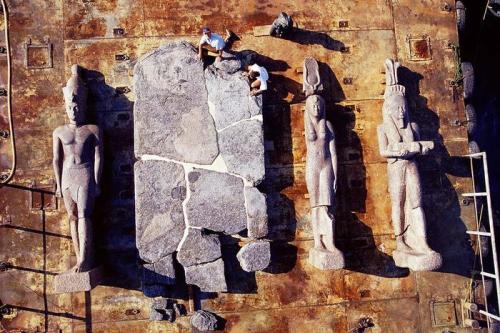

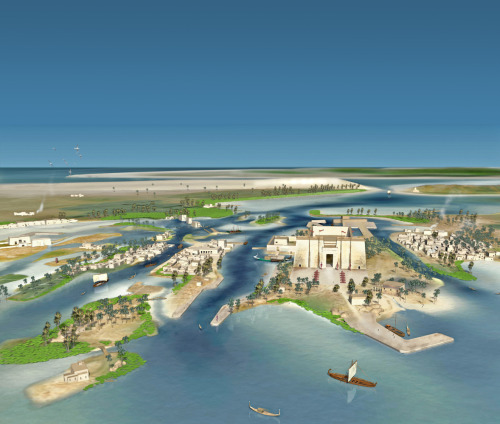
Heracleion Photos: Lost Egyptian City Revealed After 1,200 Years Under Sea
CNN Video [Breaking News]: Lost Egyptian City Revealed
It is a city shrouded in myth, swallowed by the Mediterranean Sea and buried in sand and mud for more than 1,200 years. But now archeologists are unearthing the mysteries of Heracleion, uncovering amazingly well-preserved artifacts that tell the story of a vibrant classical-era port.
Known as Heracleion to the ancient Greeks and Thonis to the ancient Eygptians, the city was rediscovered in 2000 by French underwater archaeologist Dr. Franck Goddio and a team from the European Institute for Underwater Acheology (IEASM) after a four-year geophysical survey. The ruins of the lost city were found 30 feet under the surface of the Mediterranean Sea in Aboukir Bay, near Alexandria.A new documentary highlights the major discoveries that have been unearthed at Thonis-Heracleion during a 13-year excavation. Exciting archeological finds help describe an ancient city that was not only a vital international trade hub but possibly an important religious center. The television crew used archeological survey data to construct a computer model of the city (above, last image).
According to the Telegraph, leading research now suggests that Thonis-Heracleion served as a mandatory port of entry for trade between the Mediterranean and the Nile.
So far, 64 ancient shipwrecks and more than 700 anchors have been unearthed from the mud of the bay, the news outlet notes. Other findings include gold coins, weights from Athens (which have never before been found at an Egyptian site) and giant tablets inscribed in ancient Greek and ancient Egyptian. Researchers think that these artifacts point to the city's prominence as a bustling trade hub.
Researchers have also uncovered a variety of religious artifacts in the sunken city, including 16-foot stone sculptures thought to have adorned the city's central temple and limestone sarcophagi that are believed to have contained mummified animals.
For more photos, visit Goddio's Heracleion website.
Experts have marveled at the variety of artifacts found and have been equally impressed by how well preserved they are.
"The archaeological evidence is simply overwhelming," Professor Sir Barry Cunliffe, a University of Oxford archeologist taking part in the excavation, said in a press release obtained by The Huffington Post. "By lying untouched and protected by sand on the sea floor for centuries they are brilliantly preserved."
A panel of experts presented their findings at an Oxford University conference on the Thonis-Heracleion excavation earlier this year.
But despite all the excitement over the excavation, one mystery about Thonis-Heracleion remains largely unsolved: Why exactly did it sink? Goddio's team suggests the weight of large buildings on the region's water-logged clay and sand soil may have caused the city to sink in the wake of an earthquake.
WATCH: Colossal Sunken Statues Of Thonis-Heracleion
PHOTO GALLERY: Lost city of Heracleion
From Legend to Reality
Thonis-Heracleion (the Egyptian and Greek names of the city) is a city lost between legend and reality. Before the foundation of Alexandria in 331 BC, the city knew glorious times as the obligatory port of entry to Egypt for all ships coming from the Greek world. It had also a religious importance because of the temple of Amun, which played an important role in rites associated with dynasty continuity. The city was founded probably around the 8th century BC, underwent diverse natural catastrophes, and finally sunk entirely into the depths of the Mediterranean in the 8th century AD.Prior to its discovery in 2000 by the IEASM, no trace of Thonis-Heracleion had been found. Its name was almost razed from the memory of mankind, only preserved in ancient classic texts and rare inscriptions found on land by archaeologists. The Greek historian Herodotus (5th century BC) tells us of a great temple that was built where the famous hero Herakles first set foot on to Egypt. He also reports of Helen's visit to Heracleion with her lover Paris before the Trojan War. More than four centuries after Herodotus' visit to Egypt, the geographer Strabo observed that the city of Heracleion, which possessed the temple of Herakles, is located straight to the east of Canopus at the mouth of the Canopic branch of the River Nile.
The Discovery
With his unique survey-based approach that utilises the most sophisticated technical equipment, Franck Goddio and his team from the IEASM, in cooperation with the Egyptian Supreme Council of Antiquities, were able to locate, map and excavate parts of the city of Thonis-Heracleion, which lies 6.5 kilometres off today's coastline. The city is located within an overall research area of 11 by 15 kilometres in the western part of Aboukir Bay. Franck Goddio has found important information on the ancient landmarks of Thonis-Heracleion, such as the grand temple of Amun and his son Khonsou (Herakles for the Greeks), the harbours that once controlled all trade into Egypt, and the daily life of its inhabitants. He has also solved a historic enigma that has puzzled Egyptologists over the years: the archaeological material has revealed that Heracleion and Thonis were in fact one and the same city with two names; Heracleion being the name of the city for the Greeks and Thonis for the Egyptians.The objects recovered from the excavations illustrate the cities' beauty and glory, the magnificence of their grand temples and the abundance of historic evidence: colossal statues, inscriptions and architectural elements, jewellery and coins, ritual objects and ceramics - a civilization frozen in time.
The quantity and quality of the archaeological material excavated from the site of Thonis-Heracleion show that this city had known a time of opulence and a peak in its occupation from the 6th to the 4th century BC. This is readily seen in the large quantity of coins and ceramics dated to this period.
The port of Thonis-Heracleion had numerous large basins and functioned as a hub of international trade. The intense activity in the port fostered the city's prosperity. More than seven hundred ancient anchors of various forms and over 60 wrecks dating from the 6th to the 2nd century BC are also an eloquent testimony to the intensity of maritime activity here.
The city extended all around the temple and a network of canals in and around the city must have given it a lake dwelling appearance. On the islands and islets dwellings and secondary sanctuaries were located. Excavations here have revealed beautiful archaeological material such as bronze statuettes. On the north side of the temple to Herakles, a grand canal flowed through the city from east to west and connected the port basins with a lake to the west.
—————————————————————
This is absolutely breathtaking. I'm literally speechless with chills from this video footage and photos. If anyone can find the documentary on this (in English, please), send it my way because I'd love to immerse myself in this excavation. The documentary is titled 'Egypt's Sunken City: A Legend Is Revealed'. So far, this is all Franck Goddio's team has published as far as I know; yet, the documentary was produced by the Discovery Channel, so it has to be out there somewhere. Science team…assemmmmmmble…
laboratoryequipment: Researchers Solve 20-Year Puzzle of How...

Researchers Solve 20-Year Puzzle of How Heart Regulates Beat
A 20-year puzzle as to how the heart regulates contraction appears to have been solved by researchers from the Univ. of Bristol. The findings, published in the journal Biophysics, paves the way to improving our understanding of what goes wrong when the heart fails.
When the heart beats (contracts), the contractile machinery is switched on by an increase in calcium within the cell. This increase is produced by a release from intracellular stores activated by a small influx of calcium into the cell during the cardiac electrical signal — known as the action potential.
Read more: http://www.laboratoryequipment.com/news/2013/06/researchers-solve-20-year-puzzle-how-heart-regulates-beat
Autistic People Speaking Out: The Fear
Autistic People Speaking Out: The Fear:I feel like I'm surrounded by the fear in most social situations, even with friends I really trust.
I don't know how it starts; usually something stereotypically aspie of me, like noise or crowds or uncertainty. Usually uncertainty, I think. From that point on, it's got me.
It escalates and…
New observations of a 'dust trap' around a young...
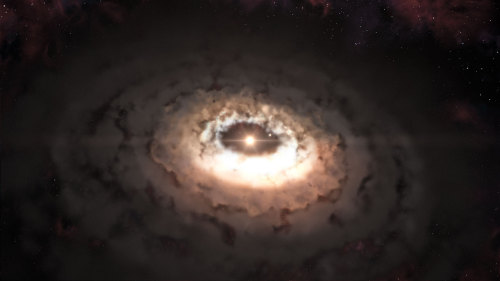
This artist's impression shows the dust trap in the system Oph-IRS 48. The dust trap provides a safe haven for the tiny rocks in the disc, allowing them to clump together and grow to sizes that allow


New observations of a 'dust trap' around a young star solve long-standing planet formation mystery
Astronomers using the new Atacama Large Millimeter/submillimeter Array have imaged a region around a young star where dust particles can grow by clumping together. This is the first time that such a dust trap has been clearly observed and modeled. It solves a long-standing mystery about how dust particles in discs grow to larger sizes so that they can eventually form comets, planets and other rocky bodies.
Astronomers now know that planets around other stars are plentiful. But they do not fully understand how they form and there are many aspects of the formation of comets, planets and other rocky bodies that remain a mystery. However, new observations exploiting the power of ALMA are now answering one of the biggest questions: how do tiny grains of dust in the disc around a young star grow bigger and bigger—to eventually become rubble, and even boulders well beyond a metre in size?
Computer models suggest that dust grains grow when they collide and stick together. However, when these bigger grains collide again at high speed they are often smashed to pieces and sent back to square one. Even when this does not happen, the models show that the larger grains would quickly move inwards because of friction between the dust and gas and fall onto their parent star, leaving no chance that they could grow even further.
Somehow the dust needs a safe haven where the particles can continue growing until they are big enough to survive on their own. Such "dust traps" have been proposed, but there was no observational proof of their existence up to now.
Bottom left image: Artist's impression of the proposed disk structure of Oph IRS 48. The brown spots represent the large and small grains. The larger grains detected by ALMA are concentrated in the dust trap at the bottom of the image. The blue represents the distribution of carbon monoxide gas. The gap in the disk is shown with the proposed planetary body that is sweeping the area clear and providing the conditions necessary to form the dust trap. Credit: Nienke van der Marel
Nienke van der Marel, a PhD student at Leiden Observatory in the Netherlands, and lead author of the article, was using ALMA along with her co-workers, to study the disc in a system called Oph-IRS 48. They found that the star was circled by a ring of gas with a central hole that was probably created by an unseen planet or companion star. Earlier observations using ESO's Very Large Telescope had already shown that the small dust particles also formed a similar ring structure. But the new ALMA view of where the larger millimetre-sized dust particles were found was very different!
"At first the shape of the dust in the image came as a complete surprise to us," says van der Marel. "Instead of the ring we had expected to see, we found a very clear cashew-nut shape! We had to convince ourselves that this feature was real, but the strong signal and sharpness of the ALMA observations left no doubt about the structure. Then we realised what we had found."
What had been discovered was a region where bigger dust grains were trapped and could grow much larger by colliding and sticking together. This was a dust trap—just what the theorists were looking for.
Bottom right image: ALMA image of the dust trap around Oph IRS 48. The distinctive crescent-shaped feature comes from the accumulation of larger dust grains in the outer regions of the disk. This provides the safe haven dust grains need to grow into larger and larger objects. Credit: ALMA (ESO/NAOJ/NRAO) / Nienke van der Marel
As van der Marel explains: "It's likely that we are looking at a kind of comet factory as the conditions are right for the particles to grow from millimetre to comet size. The dust is not likely to form full-sized planets at this distance from the star. But in the near future ALMA will be able to observe dust traps closer to their parent stars, where the same mechanisms are at work. Such dust traps really would be the cradles for new-born planets."
The dust trap forms as bigger dust particles move in the direction of regions of higher pressure. Computer modelling has shown that such a high pressure region can originate from the motions of the gas at the edge of a gas hole—just like the one found in this disc.
"The combination of modelling work and high quality observations of ALMA makes this a unique project", says Cornelis Dullemond from the Institute for Theoretical Astrophysics in Heidelberg, Germany, who is an expert on dust evolution and disc modelling, and a member of the team. "Around the time that these observations were obtained, we were working on models predicting exactly these kinds of structures: a very lucky coincidence."
The observations were made while the ALMA array was still being constructed. They made use of the ALMA Band 9 receivers—European-made devices that allow ALMA to create its so far sharpest images.
"These observations show that ALMA is capable of delivering transformational science, even with less than half of the full array in use," says Ewine van Dishoeck of the Leiden Observatory, who has been a major contributor to the ALMA project for more than 20 years. "The incredible jump in both sensitivity and image sharpness in Band 9 gives us the opportunity to study basic aspects of planet formation in ways that were simply not possible before."
This conceptual artist rending, released April 18,...
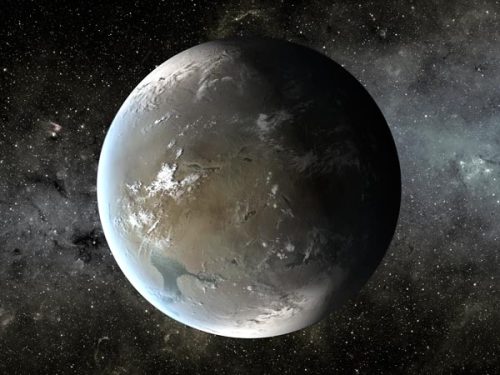
This conceptual artist rending, released April 18, shows Kepler-62f, an Earth-like planet nearly 1,200 light-years away. NASA scientists believe it orbits in the habitable zone for humans.
The planet is 40 percent larger than Earth and orbits its star, which is slightly cooler than Earth's sun, every 267 days.
The planet is believed to have a similar composition of water and land mass as our planet, but its exact components and mass are unknown, as is its current condition. Images and data received now of the planet capture light that left the planet more than a millennium ago.
geometrydaily: #457 Park – A new minimal geometric composition...

#457 Park – A new minimal geometric composition each day
alpha-beta replied to your post: The hotel I'm staying in just gave everyone a… I don't see a...
I don't see a problem.
yeah I’m still not sure there is one. So I have to wear the same shirt for a week? Oh well! At least I’ve got my book about Feynman!
periodicvideos: Lagrangian Points
Lagrangian Points
NGC 6902: The Butterfly Nebula Explanation: The bright...

NGC 6902: The Butterfly Nebula
Explanation: The bright clusters and nebulae of planet Earth's night sky are often named for flowers or insects. Though its wingspan covers over 3 light-years, NGC 6302 is no exception. With an estimated surface temperature of about 250,000 degrees C, the dying central star of this particular planetary nebula has become exceptionally hot, shining brightly in ultraviolet light but hidden from direct view by a dense torus of dust. This sharp and colorful close-up of the dying star's nebula was recorded in 2009 by the Hubble Space Telescope's Wide Field Camera 3, installed during the final shuttle servicing mission. Cutting across a bright cavity of ionized gas, the dust torus surrounding the central star is near the center of this view, almost edge-on to the line-of-sight. Molecular hydrogen has been detected in the hot star's dusty cosmic shroud. NGC 6302 lies about 4,000 light-years away in the arachnologically correct constellation of the Scorpion (Scorpius).
Image Credit: NASA, ESA, and the Hubble SM4 ERO Team
The hotel I’m staying in just gave everyone a lovely wake up call by using the fire alarm. As...
The hotel I’m staying in just gave everyone a lovely wake up call by using the fire alarm. As we evacuated the building the first thing I grabbed was my book about Feynman. Left my laptop, textbooks, and all my clothes. Just had to make sure I had Feynman with me
friendly-giant-mushroom: castielyousonofabitch: postmodernismru...

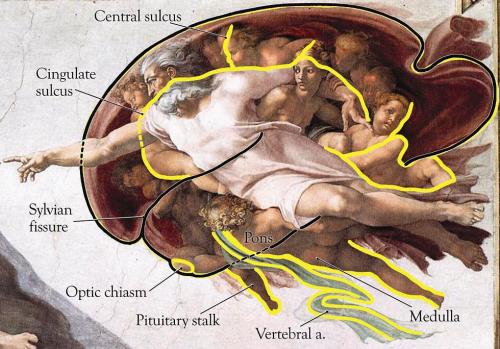
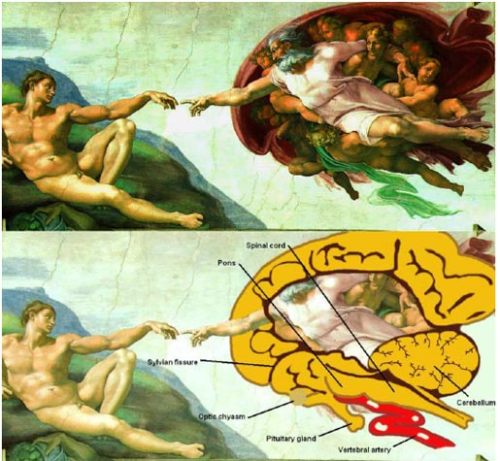
"some historians think that michelangelo was drawing god in a human brain. very few people knew what one looked like at the time; but michelangelo had dissected cadavers and would have known. it even has the hint of a brain stem. if true this would have been a great "fuck you" to the pope whom he was not friendly with but also would have meant god was in a human brain, or created by man."
Interesting.
also michelangelo painted a baby angel flipping off the pope
the blond one, you see his right hand? that's called the fig and it's an old world european gesture for 'fuck you" because apparently Pope Juluis II was a total raging asshole and everyone hated him
but nobody ever noticed this little fucker because the ceiling was so high
and then thirty years later they called michelangelo back to paint the wall behind the altar and he wasted no time in painting the gates of hell behind the pope's chair
what a badass
It amuses me to this day how much Michelangelo hated his job
He was like the Renaissance Robert Pattinson
carl-sagan-cosmos: None of you have the right to say "Sagan this, Sagan that" stating your own...
None of you have the right to say "Sagan this, Sagan that" stating your own personal opinions by saying that is what he would want, that is the most egotistical and pathetic thing you can do. Not just what's going on now… everyone. I love you all but if you want to spread something Carl Sagan said use a quote or paraphrase one.
Today while reading about Feynman at Los Alamos I learned how to square numbers near 50. You take 25...
Today while reading about Feynman at Los Alamos I learned how to square numbers near 50. You take 25 plus or minus the difference of the number you’re trying to square from 50 to get your first two digits. Then you square the difference and that number will be the last two digits of your answer. Now that's a poor explanation so here's an example.
Say you want to square 48. Well 48 is two less than 50 so 25-2=23
That means 23 will be the first two digits of the answer. Then you square 2 and get 4 (04)
48^2 = 2304
Let’s do one more
54^2:
[25+4=29 and 4^2=16]
54^2=2916
I just found that really interesting and thought I would share it with you all
"So the universe is not quite as you thought it was. You'd better rearrange your beliefs, then...."
"So the universe is not quite as you thought it was.You'd better rearrange your beliefs, then. Because you certainly can't rearrange the universe."
- Isaac Asimov (via substantia-nigra)
sciencesoup: Celestial Pinball It's not very powerful or...
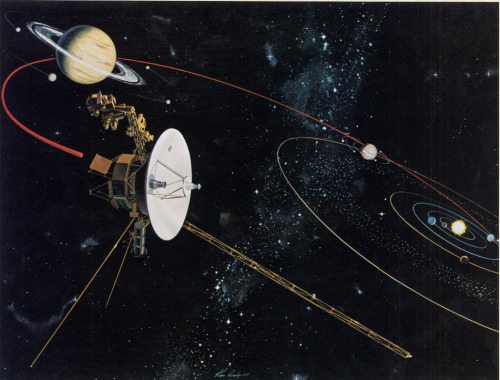
Celestial Pinball
It's not very powerful or economical to propel solar-system-traversing spacecrafts by jet propulsion alone—they need help, and it just so happens that there are a few giant celestial bodies willing to lend a hand. In 1961 scientists proposed a technique that allowed the gravity of planets to give spacecraft a boost as they flew by, accelerating them and/or changing their direction. Basically, the technique relies on the relative movement and gravity of the planet to 'fling' the spacecraft on: the spacecraft first accelerates because it falls towards the planet due to gravity, then speeds past it—and as the planet moves in orbit around the sun, away from the craft, the spacecraft gets a kick and shoots off with added speed and often a new direction. It's like celestial baseball: a ball is pitched and a bat is swung with as much force the batter can muster, and wham—the ball is knocked in a new direction with more speed. A planet and a spacecraft only interact with each other gravitationally, but the result is the same—an object that has lots of momentum transfers a little bit to another object. This means that the planet actually loses a bit of momentum, and therefore speed, due to the law of conservation of momentum. But planets are so comparatively huge that it nearly doesn't matter. Both Voyager missions picked up over 64,000 km/h from Jupiter, and over the next five billion years, Jupiter will only decelerate just enough so that the planet's orbit will fall a single millimetre short of where it would have been if the Voyagers had never passed by. This 'gravitational slingshot' saves time and fuel, and costs nothing but precise planning and a little bit of ingenuity. The main drawback to is that the planets have to be lined up just right, so missions have to fly within a certain time window. The Voyager 2 mission, for example, took advantage of a rare line up: it pinballed past Jupiter, Saturn, Uranus, and Neptune, and finally was flung it out towards the stars.
Another record-breaking Ariane 5 success for Arianespace: ATV...

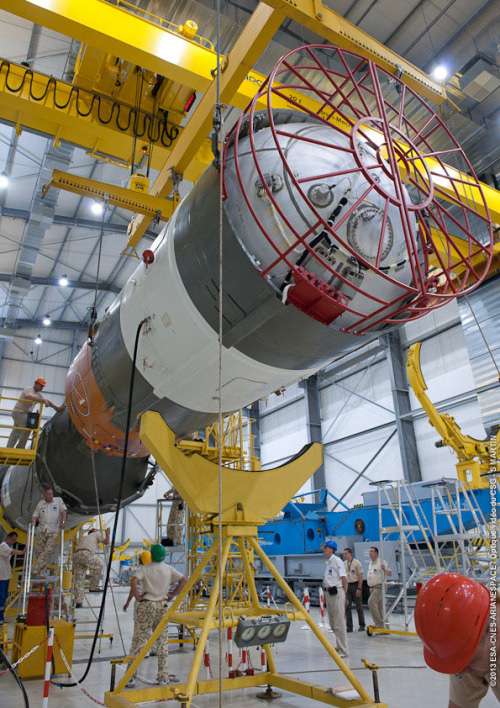
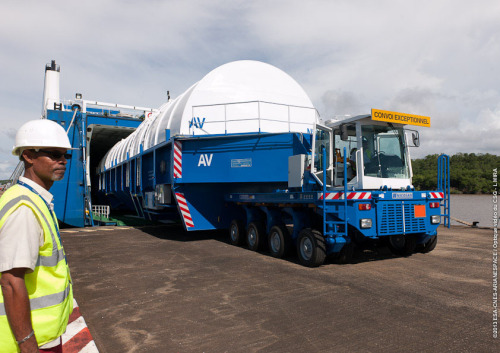
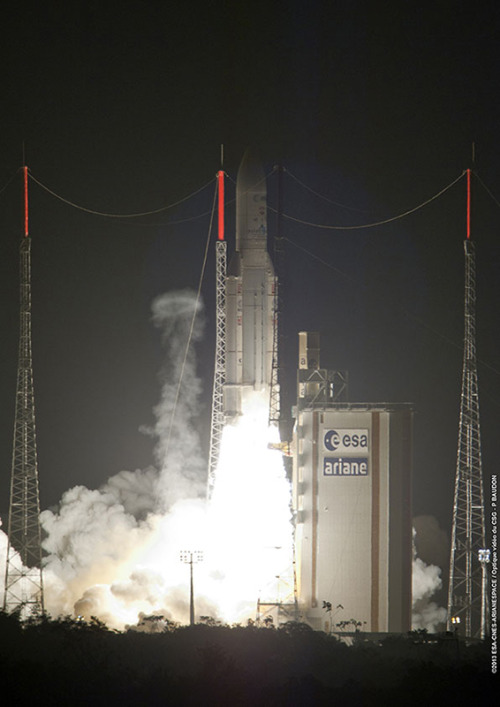
Another record-breaking Ariane 5 success for Arianespace: ATV Albert Einstein is on its way to the International Space Station
Preparations at the Spaceport for Arianespace launches are highlighted in these photos.
Top is Flight VA213's heavy-lift Ariane 5, shown in the ELA-3 launch zone prior to today's liftoff with ATV Albert Einstein.
The medium-lift Soyuz for Flight VS05 (center photo) receives its third stage inside the ELS launch site's MIK integration building, while the core cryogenic stage for Ariane 5's VA215 launcher (lower) is unloaded from a sea-going ship that arrived in French Guiana this week.
Bottom image… Ariane 5 lifts off with its heaviest payload ever – ATV Albert Einstein – at the start of the workhorse vehicle's 69th launch from French Guiana.
















No comments:
Post a Comment